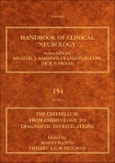The Cerebellum: From Embryology to Diagnostic Investigations, Volume 154 is designed to update the reader on the latest and clinically relevant advances in the study of cerebellar diseases in children and adults. It is organized into sections detailing: (1) Embryology, Anatomy and Function, and (2) Diagnostic investigations: Neuroimaging, and includes content on conventional sequences, diffusion tensor imaging, functional MRI, and connectivity studies. Its companion volume, The Cerebellum: Disorders and Treatment, describes disorders (starting from the fetal cerebellum, to adult cerebellum) encountered during daily practice and therapy (including insights into innovative drug and rehabilitative approaches to treat children and adults with cerebellar disorders).
Table of Contents
Section I. Introduction 1. Historical view
Section II. Embryology, Anatomy and Function 2. Embryology 3. Principles of organization of the human cerebellum: macro and microanatomy 4. Functional topography of the human cerebellum 5. Topography of the cerebellum in relationship to social brain regions and emotions 6. Physiology of the cerebellum 7. Cerebellar networks and neuropathology of cerebellar developmental disorders 8. The neuropathology of the adult cerebellum 9. Cerebellar motor syndrome from children to the elderly 10. Cognitive aspects: sequencing, behavior and executive functions 11. Language and the cerebellum
Section III. Diagnostic Investigations 12. Ultrasound and CT of the posterior fossa in neonates 13. Conventional MRI 14. Probing the neuroanatomy of the cerebellum using tractography 15. Nuclear medicine of the cerebellum 16. Genetics of cerebellar disorders 17. Laboratory investigations 18. Neurophysiology of gait 19. Neuro-ophthalmologic assessment and investigations in children and adults with cerebellar diseases 20. Scales for the clinical evaluation of cerebellar disorders








